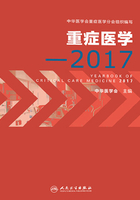
上QQ阅读APP看书,第一时间看更新
9 感染性休克患者外周血单个核细胞线粒体功能
感染性休克是感染病原体与宿主免疫系统、凝血系统等相互作用形成机体的全身炎症反应,经液体复苏仍不能纠正的低血压以及细胞代谢障碍。感染性休克导致器官血流灌注不足或功能障碍,表现为血乳酸水平增加、少尿、外周循环障碍、意识状态急性改变。感染性休克的死亡率高,发病率呈逐年上升趋势 [1,2]。在美国每年超过750 000人次罹患感染性休克,病死率更是高达50% [3]。平均每个感染性休克患者的医疗成本超过20 000欧元 [4]。虽然关于感染性休克的研究每年都有大量文献发表,集束化的治疗策略、液体复苏、器官功能支持、免疫调节、营养支持等都取得了长足的进步,但是其多器官功能障碍发生率和死亡率却仍然较高 [5,6]。线粒体功能障碍是感染性休克未来重要的治疗位点,而单个核细胞线粒体功能是临床评价线粒体功能的最有潜力的指标之一,所以我们就感染性休克患者的线粒体功能及外周血单个核细胞进行如下的综述。
一、线粒体功能不全与感染性休克
因为全身氧耗的90%都是被线粒体用来产生ATP。在临床中发现长期的全身感染患者,组织的氧分压与病情的严重性同步进展,也就是说,病情越重,组织氧分压越高 [7]。这提示问题的关键可能在于线粒体氧摄取及利用障碍导致细胞的氧利用减少,而不是氧输送不足。线粒体在感染时会产生高水平的NO和过氧化物,引起细胞内氧化磷酸化解偶联进而影响高能磷酸盐的产生,即细胞不能利用氧产生ATP,这种现象称为“细胞病性缺氧” [8]。在严重感染时,线粒体功能受到很大影响,线粒体功能不全被认为是严重感染导致多器官功能障碍的重要机制,与预后密切相关 [9-11]。线粒体膜电位降低可以触发线粒体渗透性转换孔开放,造成细胞凋亡死亡和免疫抑制的发生发展 [12,13]。即使经充分容量复苏及足够的氧供应,严重感染的患者线粒体功能不全仍会发生 [14]。Rivers等 [15]对早期收入急诊室的严重感染的患者进行的研究表明,早期目标导向性治疗确实能改善预后,但Gattinoni等 [16]对收入ICU的患者应用相似的治疗策略,却未能得到同样的结果,提示我们感染后期,线粒体功能不全发生后,提高氧输送无益。Japiassu等 [17]从感染患者中分离出的外周血单个核细胞,由于F1F0 ATP合酶活性受损导致机体无法通过提高氧耗以应对ADP的增加。并且,这种缺陷在死亡患者中更为明显。
最近Pope等 [18]的研究再次提示我们,上腔静脉血氧饱和度高于正常的患者主要问题不在于氧输送不足,应把治疗重点转向微循环和线粒体。关于线粒体功能不全的治疗越来越受到重视,但目前尚无有效的干预手段,对治疗方法的研究主要集中在以下几方面:①提供线粒体能量代谢底物,如影响糖代谢和脂质代谢的琥珀酸、丙酮酸。感染时,三羧酸循环电子传递链中复合体Ⅰ被抑制而复合体Ⅱ功能保留相对较好。琥珀酸通过复合体Ⅱ增加三羧酸循环中的电子流量和氧利用率,改善线粒体磷酸化产生ATP的能力 [19]。②提供线粒体辅因子,如辅酶Q和细胞色素C。辅酶Q在呼吸链电子传递中扮演着重要角色,是细胞呼吸和新陈代谢的催化剂 [20]。细胞色素C将呼吸链中质子从复合体Ⅲ传递到复合体Ⅳ [21]。③线粒体抗氧化剂和自由基清除剂的应用。如SS肽和谷胱甘肽。氧化应激本身与线粒体功能障碍密切相关。自由基会损害线粒体膜的通透性,从而减少ATP的生成。SS肽是一种特定的线粒体抗氧化剂,它可以与过氧化氢结合抑制脂质过氧化作用。SS肽进入生成ROS的线粒体内膜是一个不耗能的过程。通过减少活性氧的生成,SS肽能抑制线粒体肿胀和保护线粒体呼吸链的完整 [22,23]。谷胱甘肽含有一个很容易氧化脱氢的硫醇反应结构,使其成为重要的自由基清除剂 [24]。④抑制线粒体通透性转变孔开放:线粒体通透性转变孔开放是线粒体功能不全重要的发病原因。正常生理状态下,线粒体通透性转变孔呈低电导关闭状态。在缺血缺氧时,线粒体通透性转变孔呈高电导开放状态,是导致线粒体功能不全的主要机制之一 [25]。环孢素A降低线粒体通透性转变孔对Ca 2+的敏感性,抑制线粒体通透性转变孔的开放,具有线粒体保护作用 [26]。
二、感染性休克时外周血单个核细胞线粒体功能
线粒体是生物体能量产生的主要装置,三羧酸循环和氧化磷酸化都在线粒体进行,被喻为生物体内的“发电厂”。线粒体参与一系列的细胞功能调节过程,包括产生ATP,细胞内钙调节,活性氧的产生及细胞凋亡等 [27]。感染性休克多器官功能衰竭可能由线粒体功能障碍所致。除了直接导致器官功能损伤,线粒体功能受损和细胞凋亡也可以直接引起单个核细胞等免疫细胞损耗导致免疫抑制 [28]。单个核细胞是一个混合细胞体系,由淋巴细胞、单核细胞和树突状细胞等组成。单个核细胞是成熟巨噬细胞和髓系树突状细胞的前驱细胞,占外周血白细胞的5%~10%。外周血单个核细胞是机体重要的免疫细胞,参与非特异性免疫防御、特异性免疫应答和免疫调节等免疫反应的各个环节,同时也参与机体的氧化应激过程。感染、缺血是引起外周血单个核细胞线粒体氧化应激最常见的原因。单个核细胞线粒体损伤程度与机体免疫力下降情况密切相关 [12]。感染时外周血单个核细胞除了表现为线粒体DNA缺损,也表现为线粒体蛋白质合成障碍和线粒体呼吸功能受损。HIV感染者外周血单个核细胞内线粒体DNA水平与治疗相关的线粒体毒性程度相关 [29,30]。糖尿病患者线粒体呼吸链功能未发现明显差异,但是外周血单个核细胞中线粒体DNA氧化损伤严重 [31]。
免疫反应的激活是一个高耗能过程,而外周血单个核细胞线粒体功能受损则会引起免疫细胞损耗,导致机体对体内病原体的免疫应答能力受损 [17]。白细胞介素6和肿瘤坏死因子α在损伤后免疫反应中发挥重要作用,而白细胞介素6的升高往往提示预后不佳 [32,33]。失血性休克复苏后外周血单个核细胞血清白细胞介素6水平显著增加,而内毒素刺激导致的肿瘤坏死因子α生成则大幅下降。将失血性休克或脓毒症时的外周血单个核细胞置入正常血清后,外周血单个核细胞线粒体功能明显复苏,氧耗降低。而将正常的外周血单个核细胞受到失血性休克或脓毒症血清时则会诱发应激反应,导致外周血单个核细胞功能抑制,氧耗增加。HLA-DR的表达在抗原提呈和免疫系统激活发挥着至关重要的作用。而外周血单个核细胞氧化磷酸化受损同时伴随着HLA-DR表达下调 [13,34]。失血性休克复苏后的线粒体功能障碍和外周血单个核细胞对内毒素刺激的无应答反应导致的免疫抑制状态相关,血浆中细胞因子在脓毒症时外周血单个核细胞氧耗增加中发挥了重要作用 [12]。在脓毒症的患者,减少外周血单个核细胞线粒体耗氧量可以降低脓毒症的严重程度。
综上所述,在大循环复苏逐渐规范的同时,线粒体作为感染性休克影响的终末位点,越来越受到重视。受限于人体器官组织的线粒体标本很难获得,线粒体功能的检测始终是一个难题,但是外周血单个核细胞线粒体功能障碍在感染性休克的发生发展中有重要作用,同时外周血单个核细胞线粒体功能为重症患者线粒体功能的检测提供了重要窗口。进一步研究感染时外周血单个核细胞线粒体功能障碍的机制,寻求新的治疗靶点对降低感染性休克的病死率有重要意义。
(张宏民)
参考文献
1.Daniels R.Surviving the first hours in sepsis:getting the basics right(an intensivist’s perspective).J Antimicrob Chemother,2011,66(Suppl 2):ii11-23.
2.Harrison DA,Welch CA,Eddleston JM.The epidemiology of severe sepsis in England,Wales and Northern Ireland,1996 to 2004:secondary analysis of a high quality clinical database,the ICNARC Case Mix Programme Database.Crit Care,2006,10:R42.
3.Angus DC,Linde-Zwirble WT,Lidicker J,et al.Epidemiology of severe sepsis in the United States:analysis of incidence,outcome,and associated costs of care.Critical Care Medicine,2001,29:1303-1310.
4.Suffredini AF,Munford RS.Novel therapies for septic shock over the past 4 decades.JAMA,2011,306:194-199.
5.Kaukonen KM,Bailey M,Suzuki S,et al.Mortality related to severe sepsis and septic shock among critically ill patients in Australia and New Zealand,2000-2012.JAMA,2014,311:1308-1316.
6.Mouncey PR,Osborn TM,Power GS,et al.Trial of early,goal-directed resuscitation for septic shock.The New England journal of medicine,2015,372:1301-1311.
7.Boekstegers P,Weidenhfer S,Kapsner T.Skeletal muscle partial pressure of oxygen in patients with sepsis.Crit Care Med,1994,22:640-650.
8.Fink MP.Cytopathic hypoxia and sepsis:is mitochondrial dysfunction pathophysiologically important or just an epiphenomenon.Pediatric Critical Care Medicine,2015,16:89-91.
9.Srinivasan S,Avadhani NG.Cytochrome c oxidase dysfunction in oxidative stress.Free Radical Biology &Medicine,2012,53:1252-1263.
10.Takasu O,Gaut JP,Watanabe E,et al.Mechanisms of cardiac and renal dysfunction in patients dying of sepsis.American Journal of Respiratory and Critical Care Medicine,2013,187:509-517.
11.Vanasco V,Magnani ND,Cimolai MC,et al.Endotoxemia impairs heart mitochondrial function by decreasing electron transfer,ATP synthesis and ATP content without affecting membrane potential.Journal of Bioenergetics and Biomembranes,2012,44:243-252.
12.Villarroel JP,Guan Y,Werlin E,et al.Hemorrhagic shock and resuscitation are associated with peripheral blood mononuclear cell mitochondrial dysfunction and immunosuppression.The Journal of Trauma and Acute Care Surgery,2013,75:24-31.
13.Belikova I,Lukaszewicz AC,Faivre V,et al.Oxygen consumption of human peripheral blood mononuclear cells in severe human sepsis.Critical Care Medicine,2007,35:2702-2708.
14.Kozlov AV,Bahrami S,Calzia E,et al.Mitochondrial dysfunction and biogenesis:do ICU patients die from mitochondrial failure? Annals of Intensive Care,2011,1:41.
15.Rivers E,Nguyen B,Havstad S,et al.Early goal-directed therapy in the treatment of severe sepsis and septic shock.N Engl J Med,2001,345:1368-1377.
16.Gattinoni L,Brazzi L,Pelosi P.A trial of goal-oriented hemodynamic therapy in critically ill patients.SvO 2 Collaborative Group.N Engl J Med,1995,333:1025-1032.
17.Japiassu AM,Santiago AP,d’Avila JC,et al.Bioenergetic failure of human peripheral blood monocytes in patients with septic shock is mediated by reduced F1Fo adenosine-5’-triphosphate synthase activity.Critical Care Medicine,2011,39:1056-1063.
18.Pope JV,Jones AE,Gaieski DF,et al.Multicenter study of central venous oxygen saturation(ScvO 2)as a predictor of mortality in patients with sepsis.Ann Emerg Med,2010,55:40-46.
19.Dare AJ,Phillips AR,Hickey AJ,et al.A systematic review of experimental treatments for mitochondrial dysfunction in sepsis and multiple organ dysfunction syndrome.Free Radical Biology & Medicine,2009,47:1517-1525.
20.Donnino MW,Cocchi MN,Salciccioli JD,et al.Coenzyme Q10 levels are low and may be associated with the inflammatory cascade in septic shock.Crit Care,2011,15:R189.
21.Huttemann M,Pecina P,Rainbolt M,et al.The multiple functions of cytochrome c and their regulation in life and death decisions of the mammalian cell:From respiration to apoptosis.Mitochondrion,2011,11:369-381.
22.Wu XR,Liu L,Zhang ZF,et al.Selective protection of normal cells during chemotherapy by RY4 peptides.MCR,2014,12:1365-1376.
23.Dai DF,Hsieh EJ,Chen T,et al.Global proteomics and pathway analysis of pressure-overload-induced heart failure and its attenuation by mitochondrial-targeted peptides.Circulation Heart failure,2013,6:1067-1076.
24.Lowes DA,Galley HF.Mitochondrial protection by the thioredoxin-2 and glutathione systems in an in vitro endothelial model of sepsis.The Biochemical Journal,2011,436:123-132.
25.Miura T,Tanno M.The mPTP and its regulatory proteins:final common targets of signalling pathways for protection against necrosis.Cardiovascular Research,2012,94:181-189.
26.Hausenloy DJ,Boston-Griffiths EA,Yellon DM.Cyclosporin A and cardioprotection:from investigative tool to therapeutic agent.British Journal of Pharmacology,2012,165:1235-1245.
27.Osellame LD,Blacker TS,Duchen MR.Cellular and molecular mechanisms of mitochondrial function.Best Practice & Research Clinical Endocrinology & Metabolism,2012,26:711-723.
28.Vanasco V,Saez T,Magnani ND,et al.Cardiac mitochondrial biogenesis in endotoxemia is not accompanied by mitochondrial function recovery.Free Radical Biology & Medicine,2014,77:1-9.
29.Morse CG,Voss JG,Rakocevic G,et al.HIV infection and antiretroviral therapy have divergent effects on mitochondria in adipose tissue.The Journal of Infectious Diseases,2012,205:1778-1787.
30.Bociaga-Jasik M,Goralska J,Polus A,et al.Mitochondrial function and apoptosis of peripheral mononuclear cells(PBMCs)in the HIV infected patients.Current HIV Research,2013,11:263-270.
31.Wu F,Liu Y,Luo L,et al.Platelet mitochondrial dysfunction of DM rats and DM patients.International Journal of Clinical and Experimental Medicine,2015,8:6937-6946.
32.Lowes DA,Webster NR,Murphy MP,et al.Antioxidants that protect mitochondria reduce interleukin-6 and oxidative stress,improve mitochondrial function,and reduce biochemical markers of organ dysfunction in a rat model of acute sepsis.British Journal of Anaesthesia,2013,110:472-480.
33.Gouel-Cheron A,Allaouchiche B,Guignant C,et al.Early interleukin-6 and slope of monocyte human leukocyte antigen-DR:a powerful association to predict the development of sepsis after major trauma.PloS one,2012,7:e33095.
34.White JP,Puppa MJ,Sato S,et al.IL-6 regulation on skeletal muscle mitochondrial remodeling during cancer cachexia in the ApcMin/+ mouse.Skeletal muscle,2012,2:14.